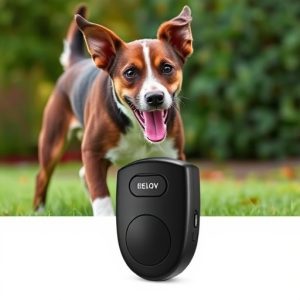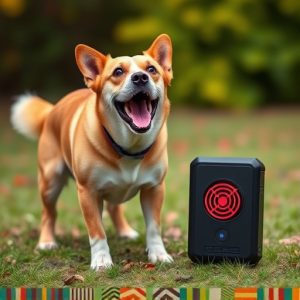Sound Wave Pet Control: Safe, Effective Electronic Deterrents Explained
Sound wave pet behavior control uses high-frequency ultrasonic waves (above 25 kHz) to modify animal…….
Sound wave pet behavior control uses high-frequency ultrasonic waves (above 25 kHz) to modify animals' behaviors, like barking or howling, non-invasively. This humane approach adheres to Electronic Pet Deterrent Safety Regulations and promotes positive reinforcement training. By targeting specific triggers without causing harm, it fosters peaceful coexistence between pets and owners, making it a popular and safe alternative for behavior management in homes with children or the elderly. Key to its success is prioritizing safety through reputable brands, understanding regional regulations, setting appropriate volume levels, and selecting devices suited for individual pet needs.
Unleash a new era in pet management with sound wave pet behavior control—a non-invasive, innovative approach. This technology harnesses the power of sound to guide and correct pet behavior without traditional barriers or aversives. Delve into this comprehensive guide exploring the science behind electronic pet deterrents, safety considerations including regulations, and real-world use cases. Understand how this technology is revolutionizing pet training while ensuring responsible and effective practices.
- Understanding Sound Wave Pet Behavior Control: A Non-Invasive Approach
- The Science Behind Electronic Pet Deterrents: How They Work
- Safety Considerations: Regulations and Best Practices for Electronic Pet Training Devices
- Effective Use Cases: Real-World Applications of Sound Wave Technology for Pet Management
Understanding Sound Wave Pet Behavior Control: A Non-Invasive Approach
Sound wave pet behavior control is a non-invasive approach that utilizes high-frequency sound waves to modify animal behavior. Unlike traditional electronic pet deterrents, which often rely on shock or noise alone, this method employs specific frequencies to create a comfortable and safe environment for pets while addressing unwanted behaviors like barking, howling, or aggressive posturing. The technology is designed with safety in mind, adhering to strict Electronic Pet Deterrent Safety Regulations to ensure it doesn’t cause harm or discomfort to animals.
This innovative solution works by targeting specific behavioral triggers, such as the frequencies produced by a dog’s bark. By emitting sound waves that are unpleasant or distracting to pets but harmless to human hearing, the device can effectively curb problematic behaviors without resorting to physical force or punishment. This not only promotes positive reinforcement training methods but also fosters a peaceful coexistence between pets and their owners, making it a popular choice for pet owners seeking humane and effective behavior management solutions.
The Science Behind Electronic Pet Deterrents: How They Work
The science behind electronic pet deterrents revolves around using sound waves to modify behavior. These devices emit specific frequencies that pets, particularly dogs and cats, find unpleasant or uncomfortable. The mechanism is based on animal perception differences compared to humans; what sounds like a high-pitched, inaudible frequency to us can be irritating or even painful for animals. This technology leverages the ability of sound waves to travel through air, allowing for non-invasive and targeted control.
Electronic pet deterrents are designed with safety regulations in mind, ensuring minimal harm to pets and humans alike. These devices typically use ultrasonic frequencies above 25 kHz, well beyond human hearing range. Safety standards, such as those set by the FDA and EPA, guide their development, testing, and marketing to guarantee effectiveness while minimizing any potential risks. Regular research and updates ensure that these deterrents remain safe and effective tools for pet behavior management.
Safety Considerations: Regulations and Best Practices for Electronic Pet Training Devices
When considering sound wave pet behavior control, or electronic pet deterrents, it’s paramount to delve into the safety considerations surrounding their use. These devices, while designed to modify pet behavior through ultrasonic or audible sounds, must adhere to stringent Electronic Pet Deterrent Safety Regulations to ensure both pet and user well-being. Best practices involve thorough research and selection of reputable brands that prioritize safety in design and testing.
Regulations vary globally, but many regions mandate specific safety standards for electronic pet training tools. These standards encompass factors like sound intensity limits, safe operating ranges, and protection against potential electrical hazards. Users should also be educated on responsible usage, including setting appropriate volume levels, understanding pet sensitivity variations, and ensuring the device is suitable for their particular pet breed and behavior profile.
Effective Use Cases: Real-World Applications of Sound Wave Technology for Pet Management
The innovative application of sound wave technology in pet behavior control has proven to be a game-changer in the field of animal management, offering effective and humane solutions for various real-world challenges. This technology utilizes specific frequencies and patterns of sound to influence an animal’s behavior without causing physical harm, making it a popular choice among pet owners, veterinarians, and animal welfare advocates alike. One of its most common use cases is in deterring unwanted behaviors like barking or scratching, where targeted sound waves can be used to calm pets down without the need for traditional, potentially harmful methods.
In more intensive settings, such as shelters and rescue centers, sound wave technology plays a crucial role in managing high-energy animals. It can help in separating aggressive dogs, reducing anxiety during transit, and even assisting in training programs by reinforcing positive behaviors. Moreover, electronic pet deterrents that adhere to strict safety regulations ensure that these devices are safe for both pets and humans, making them ideal for homes with young children or the elderly. The versatility of sound wave technology, combined with its non-invasive nature, makes it a sustainable and humane approach to pet behavior management in diverse scenarios.
Sound wave pet behavior control, as an innovative and non-invasive approach, offers promising solutions for managing pet behavior. By understanding the science behind electronic pet deterrents and adhering to safety considerations, including regulatory compliance and best practices, pet owners can effectively utilize this technology. Real-world applications demonstrate the potential of sound wave technology in various scenarios, showcasing its effectiveness as a modern tool for responsible pet management.


